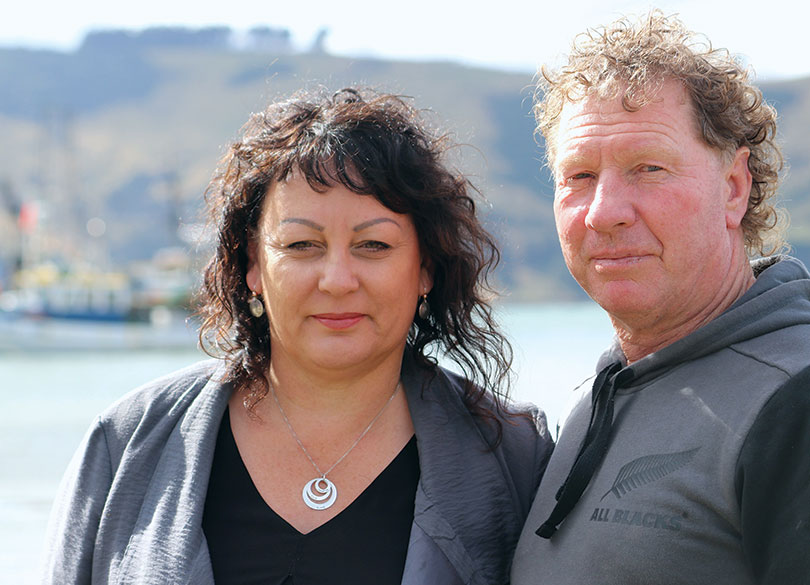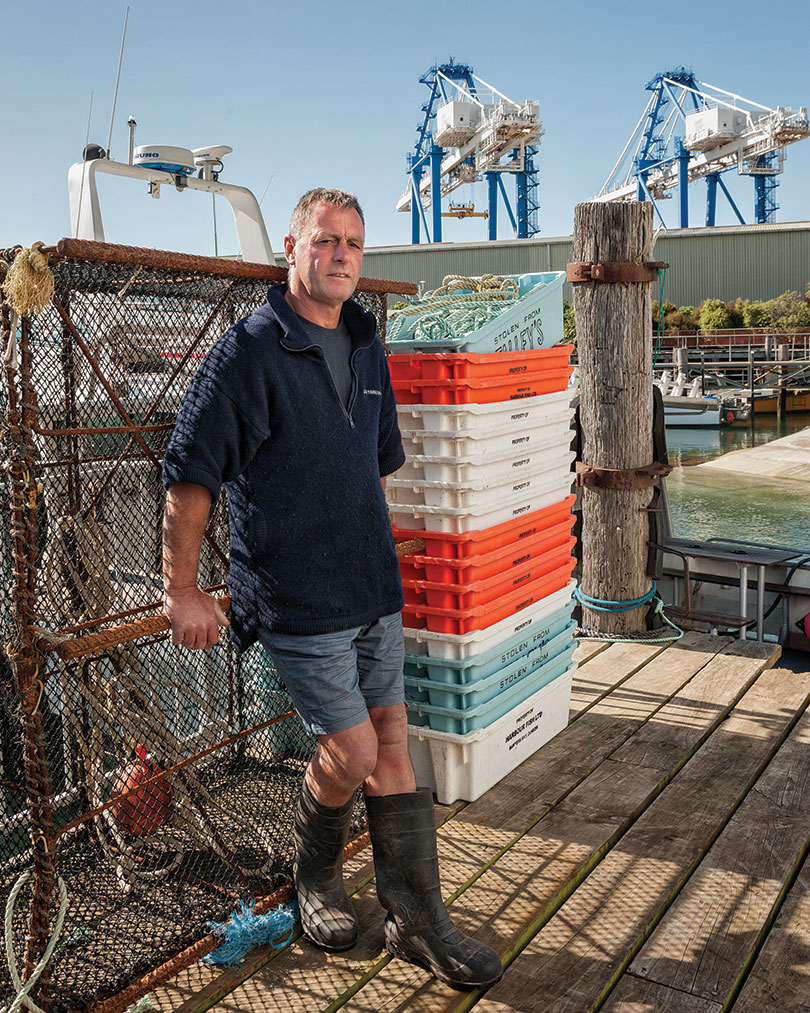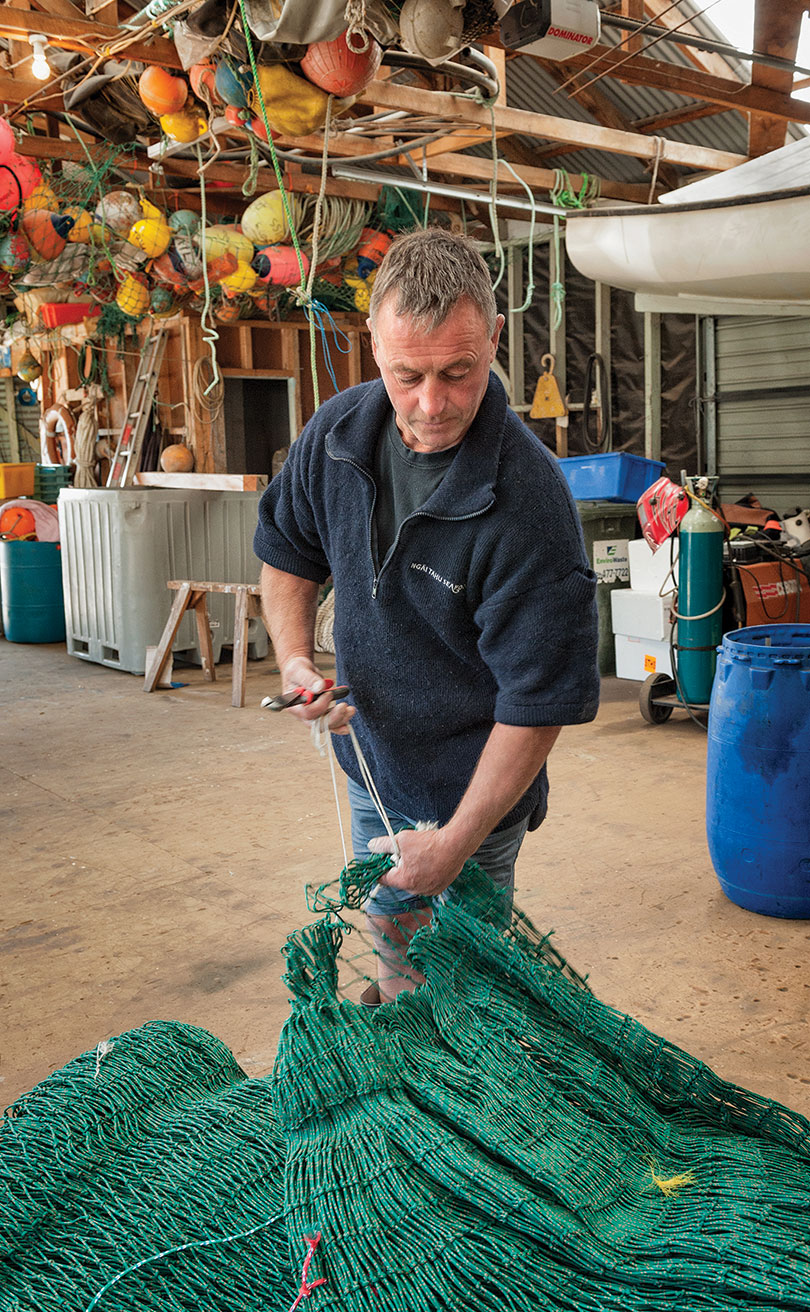Commercial Fishing – differing perspectives
Mar 31, 2019

Ngāi Tahu inshore commercial fishers believe they are being unfairly targeted for the deaths of iconic wildlife species in coastal waters they have fished sustainably for generations. They blame broad-brush campaigns by environmental lobby groups. Nā ROB TIPA.

Above: Ngāi Tahu fisher Michelle Taiaroa-McDonald and her husband Neil McDonald.
Neil McDonald and his wife Michelle Taiaroa-McDonald run an inshore fishing boat from a historic Ngāi Tahu fishing base at Ōtākou on Otago Harbour.
For Michelle, who looks after the compliance and regulations side of the business, fishing runs in her Taiaroa family’s blood. Her grandfather, father, brother, and cousins were all commercial fishermen.
Generations of her tūpuna have been skilled mariners and, as leaders of the Ōtākou kāika, developed highly specialised and successful fishing techniques to maintain the sustainability of fish stocks, and avoid any harm to bird life.
Michelle says social media uses such a broad brush that a lot of the recent information being distributed by environmental groups is totally unsubstantiated. She says it unfairly blames inshore fishers for the loss of marine mammals and seabirds, and that these losses obviously occurred elsewhere and by fishing methods not supported by them.
The couple were horrified when their children at Portobello School came home with a picture of a dolphin served on a plate with chips, in a graphic “By-catch of the Day” campaign against gill net fishing launched by the Māui and Hector’s Dolphin Defenders in 2015. Gill net fishing uses nylon nets hung vertically so that fish get trapped by their gills.
Neil and Michelle say it is frustrating to learn that their children are being fed what they call propaganda by environmentalists about barbaric fishing practices causing the wholesale slaughter of dolphins, especially when the carnage occurs on the other side of the world.
“We take it quite personally when we are being accused of killing marine animals,” Michelle says. “We know there are some methods of fishing that are worse than others, and the methods we use are at the low impact end of the industry so the results are totally controllable.”
Michelle’s husband Neil has been in the fishing industry for 40 years. He has a great love of the sea, fishing, and the lifestyle he joined when he left school.
A former president of the Port Chalmers Fishermen’s Co-operative Society, he served four years in the job as a local spokesman for the industry.
Neil has witnessed many peaks and troughs in fish and crayfish prices over the years, and counts himself lucky to have survived those cycles. He believes the quota management system has helped bring fishery catches and stocks back to stable, sustainable levels.
Ngāi Tahu Seafood started a crayfish pool in the Otago area when the iwi secured rock lobster quota. Neil qualifies to supply that pool through his marriage to Michelle and through their children, and has been catching crayfish for the iwi for the last 12 years.
“That has been our saviour, because we don’t have a winter fishery here,” he says.
“Personally I think the best thing that has happened to crayfish is that we can fish it all year now. So we’ve gone from a winter fishery where we’ve tried to catch 80–90 tonnes locally, to that total spread over the whole year.
“It’s less effort, and fishermen can work when prices are at their best.”
Neil says criticism by environmental groups that commercial fisheries are exploiting limited resources, are unaccountable for their actions, and are causing the decline of endangered species like the Hector’s dolphin is “crushing”.
He says responding to unsubstantiated claims is exhausting, and so is dealing with people who have a preconceived idea that fishers are breaking the law every day.
“Some of the propaganda that was coming out was just unbelievable,” he says. “It’s mentally draining at times.”
Neil also says that environmental groups are not interested in the huge pool of knowledge of fishers, and never ask them for their opinions of fishery stocks or wildlife observations.
“If we had an opportunity to sit down and talk to these people, I’m sure they would have a better understanding of what we do.

Above: Port Chalmers Fishermen’s Co-operative president Ant Smith.
“It’s not an industry where you can hide a lot any more. We’re regulated right up to the eyeballs and everything we do is documented.
“I can honestly say there are still areas of the industry that need to be tidied up, but they are things that we all know about. Now that we have quotas, there is a problem with what we call dumping, discarding and grading at sea.”
Grading, also known as high grading, means discarding low-value fish in favour of high-value fish, to maximise profit whilst staying within the quota. This is wasteful and damaging, as many fish that are returned to the water die.
“No-one is hiding from that, but what we’re saying is not everyone is doing that,” Neil says.
Ngāi Tahu fisherman Ant Smith grew up close enough to Careys Bay on Otago Harbour to hear marine radio weather forecasts echoing up the valley from the Port Chalmers fishing fleet tied up below his family’s home.
He started fishing just after the quota management system was introduced in 1986, qualified as a skipper, and eventually bought the fishing boat he first went to sea on over 30 years ago.
Today his business relies on 400 tonnes of quota to fish for 23 species, and takes him anywhere along the southern coastline between Timaru and Puysegur Point in Fiordland, depending on the weather and fish species targeted.
Half his quota belongs to Ngāi Tahu Seafood, and the other half to Talley’s, with whom he has had a long-standing working relationship. With the mutually beneficial support of both these companies, his business has grown steadily.
Ant has a strong family affiliation to Kāti Huirapa Rūnaka ki Puketeraki at Karitāne. He is the current president of the Port Chalmers Fishermen’s Co-operative, and says its long history, spanning 110 years, “is something to be proud of.”
The co-operative deals with a lot of negative publicity from the environmental lobby, much of it generated from overseas; which he says makes it difficult to find anyone to talk to.
“The world has changed. Everyone is interested in the sustainability of where they are getting their food, and that it is done in a humane way. They’re all positives and we shouldn’t be looking at them as negatives. We should be changing the way we work so our ethics align with society, and if we don’t do that we’re buggered.”
Ant Smith, Ngāi Tahu fisherman
The fishing industry has been open and transparent in reporting incidents of protected species captured in nets, he says. They are posted and updated regularly by the industry on the Department of Conservation website.
For example, a recent incident where Hector’s dolphins were caught in trawl nets was self-reported by the fisherman, who was distressed by the accidental by-catch.
“We probably don’t broadcast what we do enough, and we don’t actively lobby,” Ant says.
A case in point is the long-standing experience Otago fishermen have dealing with iconic seabird species such as albatrosses and penguins.
Port Chalmers Fishermen’s Co-operative members recently worked closely with the Yellow-eyed Penguin Trust to count penguins and to gain a better understanding of the trust’s point of view, “a really positive experience for both parties”, says Ant.
“There are a lot of seabird interactions, especially in this area [the Otago coast]. We’ve done a lot of mitigation with a few simple changes in our practices, so we don’t interact with seabirds much at all.”
Ant’s crew have a code of ethics on their boat to avoid attracting seabirds. They don’t dump waste at sea, and have made other minor changes in operational practices.
“The world has changed,” he says. “Everyone is interested in the sustainability of where they are getting their food, and that it is done in a humane way.
“They’re all positives and we shouldn’t be looking at them as negatives. We should be changing the way we work so our ethics align with society, and if we don’t do that we’re buggered.”
The Port Chalmers Fishermen’s Co-operative relies on Seafood New Zealand to lobby on its behalf, “but you can’t just keep rebutting what you read in the paper,” Ant says.
“The biggest issue is that we feel we are doing the right thing, and we are being persecuted falsely. That gets our backs up, and that means we don’t have a healthy relationship with some of the lobby groups.”
TE KARAKA approached a number of environmental groups who are actively campaigning against what they regard as unsustainable fishing practices that are threatening endangered wildlife in New Zealand waters.
Sea Shepherd launched its first New Zealand campaign, Operation Pahu, in September 2017 to reduce the deaths of Hector’s dolphins on southern coastlines between the Canterbury Bight and Te Waewae Bay on the Foveaux Strait coast.
The organisation believes numbers of Hector’s dolphins have declined 80 per cent in the last 50 years, and estimates that 150 dolphins are caught as by-catch in set nets and trawl nets in this area every year.
Operation Pahu campaign leader Grant Meikle (Ngāi Tahu) believes the laws are a “toothless tiger” and need to be changed to stop trawlers working in a marine mammal sanctuary in Te Waewae Bay, which is also a breeding ground for southern right whales.
Grant says until they started their patrols, no-one was policing a set net ban up to four nautical miles offshore (excluding estuaries), and a loophole in the legislation that allows trawlers with a low headline of less than a metre to operate within two nautical miles of the coast in Te Waewae Bay.
“It’s not illegal to catch a dolphin, but it is illegal not to report it,” he says.

Above: Ant Smith says that minor changes to his operational practices have reduced the risk of harming seabirds and marine mammals.
Operation Pahu approached Ōraka-Aparima Rūnaka at Colac Bay and Kāti Huirapa Rūnaka ki Puketeraki at Karitāne, and the latter endorsed the campaign in a video that appears on the Sea Shepherd website.
A spokesman for the Puketeraki rūnaka, Brendan Flack, acknowledged the leadership shown by Ngāi Tahu fishers, and their awareness of the issues within the industry.
Brendan says the goal for the rūnaka is to ensure access to an abundant and healthy local fishery for now and the future, with the East Otago taiāpure entering its third decade of mandated customary fisheries management.
Brendan says the rūnaka has worked with researchers, commercial fishers, and recreational fishers, as well as customary, community, and terrestrial authorities, landowners, and whānau to try to balance their needs with its own goals.
In January, Greenpeace accused the government of dragging the chain on the roll-out of independent cameras on all fishing boats, which it believes are urgently needed to protect the marine environment from harmful fishing practices.
At the time, Greenpeace executive director Russel Norman said the original trials of cameras on fishing boats in 2012 showed disturbing levels of malpractice. He said leaked Ministry of Primary Industries reports showed that companies unlawfully dumped half the fish they caught, and that Hector’s dolphins that drowned in nets were not reported.
In February, Forest & Bird said the New Zealand fishing industry’s own records showed it was responsible for the death of hundreds of marine mammals and thousands of seabirds every year.
It called for more transparency by the industry, and accused a few “rotten apples” of blocking the government’s proposed introduction of electronic monitoring cameras on most fishing vessels.
In mid-February, Forest & Bird reported the death of four endangered New Zealand sea lions in commercial fishing nets. In the same week, the Ministry for Primary Industries reported that four Hector’s dolphins drowned in inshore trawl nets off the South Island’s east coast, and five Antipodean albatrosses were caught on long lines in the Bay of Plenty between December 2, 2018, and January 4, 2019.
Meanwhile, Seafood New Zealand has produced a television campaign assuring New Zealanders that the industry is a responsible guardian of the oceans, has nothing to hide, and leads the world in developing better techniques and sustainable fishing practices.
“The smallest minority of fisherman are letting us down in terms of their practice. The majority of the fishers are not catching protected species, and yet we are all tarred with that same brush.”
Michelle Taiaroa-McDonald
Forest & Bird seabird advocate Karen Baird acknowledges that good fishers were being disadvantaged by irresponsible fishers.
“Forest & Bird knows there are many responsible fishers and fishing companies – we work with them on sustainable fishing projects to protect birds and ocean wildlife,” she says.
“Despite the good efforts of some fishers, seabird by-catch isn’t reducing. It has been at very high levels for 10 years, with thousands of seabirds and hundreds of marine mammals dying on lines and in nets every single year.
“The public are rightly concerned by these numbers, and struggle to trust the fishing industry when its leaders actively oppose measures which would help protect these animals – things like marine reserves, mandatory mitigation measures, and cameras on boats.
“If fishers are serious about winning back public support, they need to convince industry leaders to end their opposition to measures which would help stop unsustainable fishing practices like dumping, high-grading, and misreporting.”
Michelle Taiaroa-McDonald challenges environmental groups to stop blaming inshore fishermen for the actions of others, often deep sea vessels working offshore or vessels working elsewhere around the New Zealand coast.
She says their claims need to be substantiated by facts clearly stating where each incident occurred, when it occurred, and by what fishing method. If they did this, she believes the “army against unsupported fishing methods would double.”
“The smallest minority of fisherman are letting us down in terms of their practice,” Michelle says. “The majority of the fishers are not catching protected species, and yet we are all tarred with that same brush.”
Michelle says most fishers are conservationists who love the lifestyle and the environment.
“You can’t just go out there and trawl for fish without being aware of the cycles of what’s happening on land and under water, and adjusting your methods to suit, so that you are not becoming a burden on the environment.
“That’s the skill and expertise of these people out there – that they know when to fish, where to fish, and how to fish.”